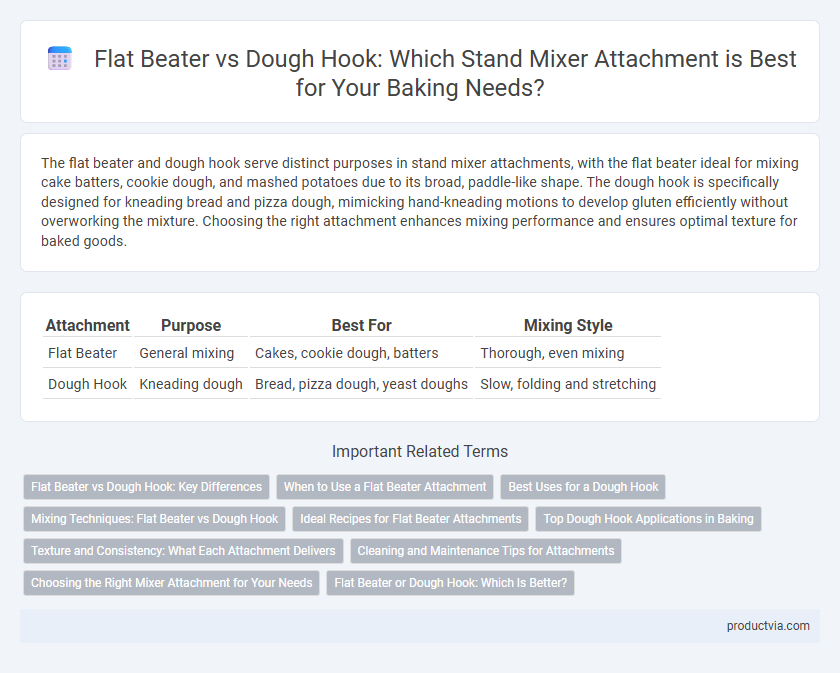The flat beater and dough hook serve distinct purposes in stand mixer attachments, with the flat beater ideal for mixing cake batters, cookie dough, and mashed potatoes due to its broad, paddle-like shape. The dough hook is specifically designed for kneading bread and pizza dough, mimicking hand-kneading motions to develop gluten efficiently without overworking the mixture. Choosing the right attachment enhances mixing performance and ensures optimal texture for baked goods.
Table of Comparison
| Attachment | Purpose | Best For | Mixing Style |
|---|---|---|---|
| Flat Beater | General mixing | Cakes, cookie dough, batters | Thorough, even mixing |
| Dough Hook | Kneading dough | Bread, pizza dough, yeast doughs | Slow, folding and stretching |
Flat Beater vs Dough Hook: Key Differences
The flat beater is ideal for mixing medium to heavy batters, such as cake batter, cookie dough, and mashed potatoes, providing thorough and even mixing without overworking the ingredients. In contrast, the dough hook is specifically designed for kneading yeast doughs like bread and pizza dough, efficiently developing gluten structure without straining the motor. Choosing between the flat beater and dough hook depends on the recipe's texture and consistency requirements, ensuring optimal mixing results.
When to Use a Flat Beater Attachment
The flat beater attachment is ideal for mixing medium-thick batters, cookie dough, and cake mixes, providing thorough blending without overworking the ingredients. It excels at combining butter and sugar, creaming mixtures, and mixing heavier mixtures where a dough hook would be less effective. Use the flat beater for tasks requiring even incorporation and minimal air incorporation, ensuring consistent texture in cookies, cakes, and mashed potatoes.
Best Uses for a Dough Hook
A dough hook is specifically designed for kneading heavy, elastic doughs such as bread or pizza, ensuring efficient gluten development without overworking the mixture. Unlike flat beaters, dough hooks can handle thick and sticky doughs by mimicking hand kneading motions, which makes them ideal for yeast-based recipes. Using a dough hook reduces preparation time and improves dough texture, enhancing the final baked product's rise and crumb structure.
Mixing Techniques: Flat Beater vs Dough Hook
The flat beater excels at mixing medium to heavy batters, such as cookie dough and cake mixtures, by thoroughly combining ingredients without overworking the batter. The dough hook is specifically designed for kneading yeast doughs, efficiently developing gluten structure while reducing mixing time and preventing damage to the dough. Utilizing the appropriate attachment enhances mixing performance and achieves optimal texture for specific culinary applications.
Ideal Recipes for Flat Beater Attachments
Flat beater attachments in stand mixers are ideal for mixing medium-density batters like cake, cookie dough, and mashed potatoes, providing thorough blending without overworking ingredients. This attachment excels at combining ingredients smoothly for recipes that require aeration and consistent texture but do not need heavy kneading. Flat beaters maintain the perfect balance for batters and mixtures that demand gentle mixing to achieve light and tender results.
Top Dough Hook Applications in Baking
The dough hook attachment is specifically designed for kneading heavy, dense bread doughs, efficiently developing gluten without tearing the dough. Its spiral or C-shaped design provides optimal mixing action for yeast doughs, making it ideal for preparing bread, pizza, and pasta. Using a dough hook reduces manual effort and ensures consistent dough texture and elasticity crucial for successful baking results.
Texture and Consistency: What Each Attachment Delivers
The flat beater produces a smooth, uniform texture ideal for batters, cookie doughs, and cake mixtures by thoroughly combining ingredients without overworking them. The dough hook specializes in kneading heavy, elastic doughs, developing gluten for a consistent, chewy texture essential in bread and pizza crusts. Selecting the appropriate attachment ensures optimal mixing performance tailored to the desired dough or batter consistency.
Cleaning and Maintenance Tips for Attachments
Flat beaters and dough hooks, common mixing attachments, require distinct cleaning and maintenance approaches to preserve their functionality. Flat beaters, often made from metal or coated materials, should be hand-washed with warm soapy water to avoid coating damage, while dough hooks, typically stainless steel, can withstand dishwasher cycles but benefit from immediate drying to prevent rust. Regular inspection for residue buildup and ensuring thorough drying helps extend the lifespan of both attachments and maintains optimal mixer performance.
Choosing the Right Mixer Attachment for Your Needs
Flat beaters are ideal for mixing cake batters, cookie dough, and other medium-consistency mixtures due to their wide, flat design that ensures thorough blending without overworking ingredients. Dough hooks excel at kneading bread and pizza dough, effectively mimicking hand kneading by stretching and folding sticky, heavy dough without straining the mixer motor. Selecting the appropriate attachment enhances mixing efficiency, texture, and overall baking results, making it essential to match your flat beater or dough hook choice to your specific recipe requirements.
Flat Beater or Dough Hook: Which Is Better?
The flat beater excels at mixing medium-density ingredients like cake batter, cookie dough, and mashed potatoes, providing thorough and consistent blending without overworking the mixture. The dough hook, designed specifically for kneading yeast doughs such as bread, pizza, and pasta, effectively develops gluten by mimicking manual kneading motions, ensuring optimal texture and rise. Choosing between the flat beater and dough hook depends on the recipe requirements, with the flat beater preferred for batters and softer mixtures while the dough hook is essential for heavy, elastic doughs.
Flat beater vs Dough hook for mixing attachments Infographic

 productvia.com
productvia.com